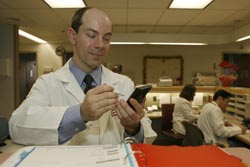Simple online methods increase physician disease reporting
Public health depts. can act more quickly on emerging outbreaks
| With emerging diseases like the West Nile Virus, and re-emerging diseases such as the pandemic flu and drug-resistant tuberculosis, it’s increasingly important to promptly detect a potential infectious outbreak within a community. But public health officials can’t act quickly unless physicians report the diseases. | |
 Photo Ryan Brandenberg/Temple University
Lawrence Ward, M.D., M.P.H.
|
“Quick reporting by several physicians, all acting independently, allows the public health authorities to promptly recognize a pattern and take the necessary action to contain the disease by isolating and treating cases, quarantining affected groups and taking other measures to hopefully prevent a wider outbreak,” said Temple University physician Dr. Lawrence Ward, MD, MPH, FACP. Ward is an assistant professor of medicine, an associate program director of the internal medicine residency program and medical director of the Medicine Group Practice at Temple University Hospital. |
|
Ward led a study published in the January issue of the Journal of Public Health Management and Practice that found simple and cost efficient methods such as e-mail reminders, an informational web site, and a program for handheld devices significantly increased spontaneous reporting by physicians. “Currently, few physicians report diseases to public health authorities. They either don’t know the methods for reporting, or the specific conditions that are required by law to be reported. Public health officials also do not adequately communicate the vitally important role played by practicing physicians, as frontline agents of public health, in the identification of new disease patterns and the importance of prompt reporting,” Ward said. The study involved clinicians associated with all hospitals in Philadelphia County, Pa. The study comprised a 24-week baseline period (Jan. 18, 2004–July 3, 2004) and a 24-week intervention period (Jan. 16, 2005–July 2, 2005). Researchers selected five hospitals for the intervention group, while the control group consisted of the 23 other hospitals located within Philadelphia County. The intervention group received e-mails directing readers to a web site* that listed all reportable conditions with instructions on how to report to authorities. The site also allowed doctors to download a program onto their handheld devices that would make this information easily accessible and help facilitate reporting to the Department of Public Health. During the intervention period, the e-mails were distributed three times, each reaching in excess of 16,500 individuals. There were a total of 886 visits to the web site, 207 downloads of a poster of reportable diseases, 130 downloads of the handheld device reporting program, and 122 downloads of the Philadelphia Department of Public Health case report form. From the baseline to the intervention period, there was a mean increase of 5.6 reports in the intervention group and a mean decrease of 3.0 reports in the control group. “The difference between the two groups was significant and supported the protocol as a way to increase reporting among clinicians,” Ward said. “Using the internet had not yet been studied. Past studies have examined costly, time-intensive and unsustainable methods to increase reporting such as newsletters and mailed reminders.” In contrast to other methods studied, Ward and his colleagues believe their method is affordable and sustainable, with a format that’s easily understood by today’s internet-savvy clinician. They estimate that only 26 hours of person-time and $350 were used in developing the internet page, handheld computer program and e-mail memorandums, not including the cost of establishing and maintaining the underlying hospital web site. Despite the promising results, more works lies ahead for Ward in educating clinicians about the importance of reporting diseases. A review of the disease coding data strongly suggests significant underreporting, even in the intervention hospitals used for this study, he said. Reasons for physician underreporting are numerous. Some physicians incorrectly believe that if a laboratory reports a disease, they are not required to do so as well. Many physicians also incorrectly believe that reporting would violate HIPAA, or patient privacy regulations, he added. Ward encourages clinicians to sign up to use an online reporting system, already used by labs, from the state of Pennsylvania called PA-NEDSS (https://www.nedss.state.pa.us/nedss). Ward together with his wife, Stephanie Ward, MD, MPH, also a physician in the Department of Medicine at Temple University, coordinates the public health elective course for Temple’s School of Medicine and is working with the school to integrate more public health topics in the regular Medical School curriculum. “I am interested in further educating physicians on their vital role as frontline members of the public health system,” Ward said. “Clinical medicine and public health were once integral partners in maintaining health. Unfortunately, we have gotten away from that, and with the emergence of new diseases over the last few years, we have been reminded of the need to work together and understand each other better. Our study highlighted one way we can do that since the underreporting of diseases could lead to misplaced resources that might be sorely needed elsewhere.” — Written by Anna Nguyen *Web site: www.uphs.upenn.edu/bugdrug/antibiotic_manual/
Other authors are C. Victor Spain, DVM, PhD, Philadelphia Department of Public Health; Mindy J. Perilla, MPH, Philadelphia Department of Public Health; Knashawn H. Morales, Sc.DCenter for Clinical Epidemiology and Biostatistics; Department of Biostatistics and Epidemiology, University of Pennsylvania; and Darren R. Linkin, MD, MSCE, Division of Infectious Diseases; Department of Medicine; Center for Clinical Epidemiology and Biostatistics; Department of Biostatistics and Epidemiology, University of Pennsylvania, and Philadelphia VA Medical Center, Philadelphia, PA. Funding was provided by The Mentored Patient Oriented Research Career Development Award (K23-AI-060887-01) of the NIH from the National Institute of Allergy and Infectious Diseases (D.R.L.). |
|